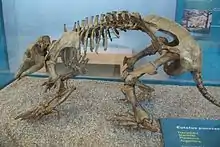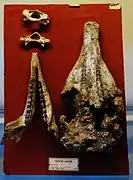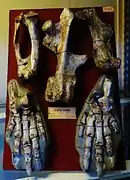Eutatus
Eutatus is an extinct genus of large armadillos of the family Dasypodidae. It was endemic to South America from the Early Miocene to Late Pleistocene, living from 17.5 Ma-11,000 years ago, with possible survival into the early Holocene (~ 7,500 BP)[2] and existing for approximately 17.49 million years .[1] Based on carbon isotope ratios, it is thought to have been an herbivore that fed on grasses.[2]
| Eutatus | |
|---|---|
 | |
| Eutatus punctatus skeleton | |
 | |
| Eutatus punctatus armour | |
| Scientific classification | |
| Kingdom: | Animalia |
| Phylum: | Chordata |
| Class: | Mammalia |
| Order: | Cingulata |
| Family: | Dasypodidae |
| Genus: | †Eutatus Gervais 1867 |
| Species[1] | |
Taxonomy
Eutatus was named by Gervais (1867). The type species is E. seguini. It was assigned to Dasypodidae by Carroll (1988).[3]
Fossil distribution
The fossil remains are confined to Argentina and have been found in the Santacrucian Santa Cruz Formation,[4] Ensenadan Miramar Formation,[5] and the Lujanian Luján Formation.[6]
Gallery
 Skull
Skull Limbs
Limbs
References
- Eutatus at Fossilworks.org
- Prado, J. L.; Martinez-Maza, C.; Alberdi, M. T. (2015). "Megafauna extinction in South America: A new chronology for the Argentine Pampas". Palaeogeography, Palaeoclimatology, Palaeoecology. 425: 41–49. doi:10.1016/j.palaeo.2015.02.026.
- R. L. Carroll. 1988. Vertebrate Paleontology and Evolution. W.H. Freeman and Company
- Coy Inlet at Fossilworks.org
- Punta Hermengo at Fossilworks.org
- Paso Otero-Pardo at Fossilworks.org
This article is issued from Wikipedia. The text is licensed under Creative Commons - Attribution - Sharealike. Additional terms may apply for the media files.